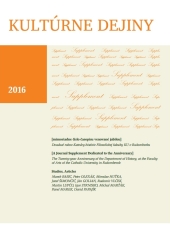Slovenská rodobrana v druhej fáze pôsobenia (september 1923 – december 1925)
The Slovak “Rodobrana” in the Second Phase of Action (September 1923 – December 1925)
Author(s): Igor StrniskoSubject(s): History
Published by: VERBUM - vydavateľstvo Katolíckej univerzity v Ružomberku
Keywords: The Rodobrana (Hlinka's) Slovak People's Party; Vojtech Tuka; Vojtech Hudec; Fascism; radicalism; investigation; 1923 – 1925
Summary/Abstract: The process of the formation of political parties, as well as the penetration of different ideologies within Slovakia, in the early 1920’s, brought with it risks that may not correspond with the official position of government officials, in order to ensure the democratic development of the state. In order to gain more influence and a more privileged status, political parties from both sides of the spectrum resorted to an intimidation of their opponents by breaking up each other’s public gatherings, where there was often also bloodshed. The penetration of totalitarian ideologies, whether Fascism or Communism, strengthened the efforts of radicals to enforce their goals. The power and political interests of Hungary and Poland, leading to the revision of a common border, a secret network of agents and the attempt to fulfil the personal ambitions of some people, only favoured these activities. In this study, we will focus on the Rodobrana, a semi-illegal organisation (Hlinka’s) Slovak People's Party (H)SPP, of which the members’ activities often went beyond the Law and rippled passions in Czechoslovak society.The Rodobrana was officially established as a “convener” organisation, which had the task of ensuring order and to protect the speakers of (Hlinka´s) Slovak People’s Party at meetings and celebrations. Adalbert Tuka later commented that through the organising of the Rodobrana he was inspired by Jednota slovenských junákov (JSJ), which has already worked in the Slovak National Party. In addition, he outlined the real goal, which the organisation was led by. On the basis of the frequent riots and street battles by the Rodobrana (especially with voters and supporters of the Communist Party, the pro-government oriented party Social Democrats and the Agrarian Party), the Rodobrana was officially disbanded on August 30th, in 1923. This prohibition was not revoked until a definitive abolition of the organisation, in January 1929.At the beginning of the second phase of the Rodobrana action, in September 1923, it has started an extensive investigation and persecution of the Rodobrana, which resulted in a significant weakening of its activities. The Rodobrana leaders went on the defensive, which means that the Rodobarana went to other friendly organisations and associations (TJ Orol, the Society of Saint Adalbert, Omladina, Kresťanské združenie slovenských roľníkov, Zväz slovenských železničiarov). The leadership of the Slovak National Party responded to this situation, so that in May 1924, they declared the Rodobarana organisers together with local organisations of the Slovak National Party team. The intention was to provide legal protection. From time to time, information about the Rodobrana penetrated to the public, its members operated covertly and waited for an opportunity for a reappearance into the public. The chances of a legal appearance came with the municipal elections, in the autumn of 1925.In the pre-election agitation, the Rodobrana were supposed to help to convene parties to distribute leaflets, provide information and agitate among the people. At the end of 1925, the Rodobrana were supposed to reportedly have 20 000 to 25 000 members. According to the conversion of membership by TJ Orol (Gymnastic Catholic Association Eagle) for the year 1924, one would be more inclined towards the number18 000 to 20 000 active Rodobrana. The Slovak People´s Party triumphed in the elections, within Slovakia, with a gain of just over 34% of the vote, which earned its 23 parliamentary seats. The electoral success of the parent parties allowed the Rodobrana to appear in public once again. The topic content, however, goes beyond this study; therefore, I recommend my readers to my and Karpáty´s dissertation on the Rodobrana, as well as the memoir “Welfare of the country - the highest law!” by A. Hruboň, which together with other studies and articles listed on the Rodobrana, offers the reader a more complete picture of the activities of the paramilitary organisation in the next years of its existence.
Journal: Kultúrne dejiny
- Issue Year: 7/2016
- Issue No: Supplem
- Page Range: 97-116
- Page Count: 20
- Language: Slovak

